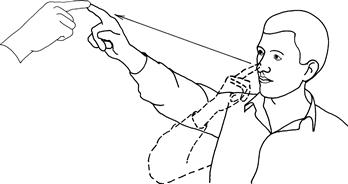Coordination
BACKGROUND
A coordinated combination of a series of motor actions is needed to produce a smooth and accurate movement. This requires integration of sensory feedback with motor output. This integration occurs mainly in the cerebellum.
In the presence of weakness, tests for coordination must be interpreted with caution and are unlikely to be informative if there is significant weakness.
Loss of joint position sense can produce some incoordination (sensory ataxia). This is made substantially worse when the eyes are closed. Joint position sense should be tested before coordination.
WHAT TO DO
Test the gait (see Chapter 4).
In all tests, compare right with left. Expect the right hand to be slightly better (in a right-handed person).
Arms
Ask the patient to hold his arms outstretched and ask him to close his eyes. Tell the patient to keep his arms in this position. Then push his arm up or down suddenly.
Finger–nose test
Hold your finger out about an arm’s length in front of the patient. Ask the patient to touch your finger with his index finger and then touch his nose (Fig. 23.1). When he has done this correctly, ask him to repeat the movement faster. Watch for accuracy and smoothness of movement.

Figure 23.1 The finger–nose test
Repeated movements
Ask the patient to pat one hand on the back of the other quickly and regularly (demonstrate).
Ask the patient to twist his hand as if opening a door or unscrewing a light bulb (demonstrate).
Ask the patient to tap the back of his right hand alternately with the palm, and then the back of his left hand. Repeat with the right hand (demonstrate).





